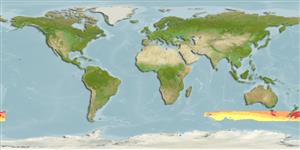Common names from other countries
>
Zeiformes (Dories) >
Oreosomatidae (Oreos) > Oreosomatinae
Etymology: Allocyttus: Greek, allos = other + Greek, kyttaros, kytos = a convex cavity; niger: niger refers to the blackish color of freshly caught specimens. It also reflects the common name "black oreo", which has been widely used in the New Zealand deepwater fishery for several years (Ref. 27159).
Environment: milieu / climate zone / depth range / distribution range
بوم شناسي
دريايي ناحیه ای از منطقه اقیانوسی با عمق بین 1000 تا 4000 متر. موجوداتی که در آبهای آزاد بین اعماق 1000 تا 4000 متر زندگی و تغذیه می کنند; اقیانوس رو (Ref. 51243); تغييرات عمق 560 - 1300 m (Ref. 6390). Deep-water; 43°S - 55°S, 65°E - 174°W (Ref. 27159)
Southwest Pacific: New Zealand and Australian waters south of 43°S, and south of Tasmania at 47°S. Also Ref. 26139.
Length at first maturity / Size / Weight / سن
Maturity: Lm ?, range 36 - ? cm
Max length : 47.0 cm TL جنس نر / بدون خواص جنسي; (Ref. 6390); common length : 35.0 cm TL جنس نر / بدون خواص جنسي; (Ref. 9258); بيشينه وزن گزارش شده: 1.5 kg (Ref. 6390); بيشينه سن گزارش شده: 100 سال ها (Ref. 27140)
Found close to the sea bed in deep water. Form large shoals over rough ground near pinnacles and canyons. Juveniles are pelagic and inhabit oceanic waters. They tend to be dispersed over smooth grounds (Ref. 6390). Feed mainly on salps and benthic crustaceans (Ref. 27150). Eggs float near the sea surface and larvae also inhabit surface waters (Ref. 6390). Based on trawl catch rates, there is no evidence of vertical migration during day or night (Ref. 27150).
Life cycle and mating behavior
بلوغ | تولید مثل | تخم ریزی | تخم ها | Fecundity | توزاد ( لارو)
Displays seasonally synchronised reproduction.
James, G.D., T. Inada and I. Nakamura, 1988. Revision of the oreosomatid fishes (Family Oreosomatidae) from the southern oceans, with a description of a new species. N.Z. J. Zool. 15:291-326. (Ref. 27159)
وضعيت در فهرست قرمز IUCN (Ref. 130435)
CITES (Ref. 128078)
Not Evaluated
خطر برای انسان ها
Harmless
استفاده انسانی
ماهي گيري – شيلات: تجاري
اطلاعات بيشتر
مراجعآبزي پرورينمايه آبزي پرورينژادهاژنتيكElectrophoresesوارثبيماري هافرآوریMass conversion
همكارانعکس هاStamps, Coins Misc.صداهاسيگواتراسرعتنوع شناگریمنطقه آبششيOtolithsمغزهابینایی
ابزارها
گزارش های ويژه
بارگيری XML
منابع اينترنتي
Estimates based on models
Preferred temperature (Ref.
115969): 2.1 - 6.8, mean 5.1 (based on 63 cells).
Phylogenetic diversity index (Ref.
82804): PD
50 = 0.5635 [Uniqueness, from 0.5 = low to 2.0 = high].
Bayesian length-weight: a=0.01413 (0.00715 - 0.02792), b=3.03 (2.85 - 3.21), in cm Total Length, based on LWR estimates for this species & (Sub)family-body (Ref.
93245).
Trophic level (Ref.
69278): 3.5 ±0.50 se; based on food items.
جهندگی (Ref.
120179): خیلی آهسته, كمينه زمان لازم براي دو برابر شدن جمعيت بيش از 14 سال (tmax=100; tm=27; Fec >5,000).
Fishing Vulnerability (Ref.
59153): High to very high vulnerability (69 of 100).
Climate Vulnerability (Ref.
125649): Moderate vulnerability (40 of 100).
